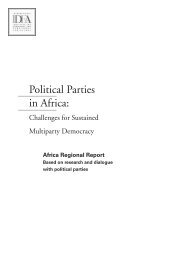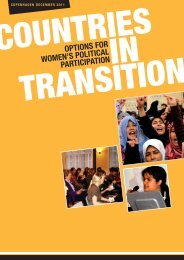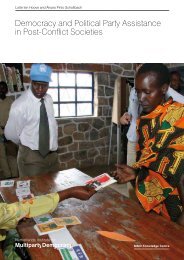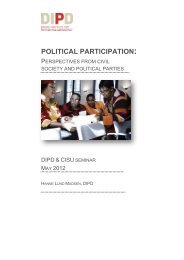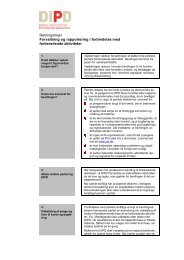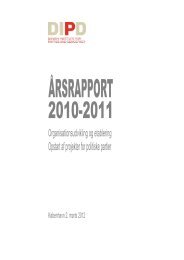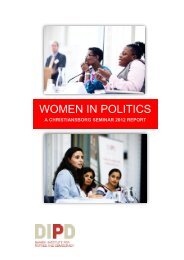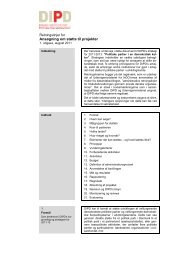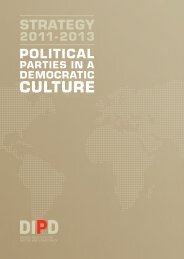Background Document - Danish Institute for Parties and Democracy
Background Document - Danish Institute for Parties and Democracy
Background Document - Danish Institute for Parties and Democracy
You also want an ePaper? Increase the reach of your titles
YUMPU automatically turns print PDFs into web optimized ePapers that Google loves.
On the municipal level, developments in female representation mirror those of<br />
Parliament, though women’s representation in local politics still lags behind the national<br />
level.<br />
FIGURE 2<br />
Women’s representation in municipalities <strong>and</strong> in Parliament 1918-2006<br />
%<br />
40<br />
35<br />
30<br />
25<br />
20<br />
15<br />
10<br />
5<br />
0<br />
1918<br />
1926<br />
1934<br />
1942<br />
1950<br />
PARLIAMENT MUNICIPALITIES<br />
1958<br />
FROM EQUALITY BEFORE THE LAW TO GENDER MAINSTREAMING<br />
Why did it take a hundred years to achieve political participation on an equal level?<br />
A very significant explanation is the fact that <strong>for</strong> centuries, feminism was hobbled<br />
by a theoretical deficiency in relation to liberalism <strong>and</strong> socialism, modernity’s two<br />
other political ideologies. Whereas the latter were <strong>for</strong>mulated by the male academic<br />
elite based on major new theories of politics, economics, sociology, <strong>and</strong> history, feminism<br />
did not gain an academic foothold until the 1970s.<br />
While it is true that the University of Copenhagen (the only university in Denmark<br />
at the time) opened its doors to female students in 1875, <strong>and</strong> that female academics<br />
returned the favour by getting involved in the women’s cause – two of the first four female<br />
Members of Parliament were academics – research positions were long reserved<br />
<strong>for</strong> men. And even if a woman managed to squeeze through the eye of the needle, this<br />
was due to merits in traditional fields of research.<br />
Commitment to feminist politics was relegated to off-duty hours up until the second<br />
feminist wave, in which a large, young, <strong>and</strong> highly educated generation of women<br />
occupied universities <strong>and</strong> under the motto of Research of women, by women, <strong>for</strong> women<br />
developed theories on the societal import of gender that finally put feminism on a<br />
scholarly par with liberalism <strong>and</strong> socialism.<br />
By organising the insights that had run as a subtext throughout the feminist criticism<br />
of liberalism <strong>and</strong> socialism since the democratic transition in the late eighteenth<br />
century, women’s studies <strong>and</strong> gender studies <strong>for</strong>ged the basis <strong>for</strong> new <strong>and</strong> effective<br />
strategies, including affirmative action towards the underrepresented gender <strong>and</strong><br />
gender mainstreaming.<br />
WOMEN IN POLITICS DANISH INSTITUTE FOR PARTIES AND DEMOCRACY PAGE 53<br />
1966<br />
1974<br />
1982<br />
1990<br />
1998<br />
2006



